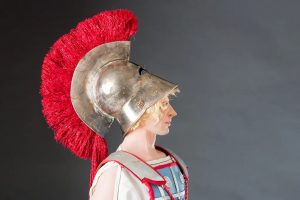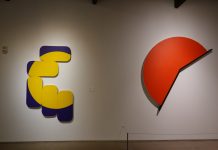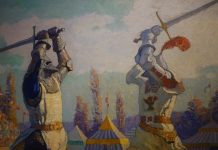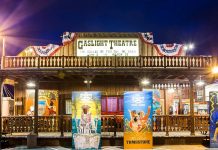Getting up close with Alexander the Great is just one of the many treats that await at Tucson’s Mini Time Machine Museum of Miniatures. On display now are figures that evoke the greatness of ancient Greek culture, all of them made by America’s foremost maker of figurines, George Stuart.
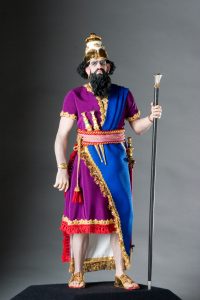
No detail is left unfinished on a figurine, including minute physical characteristics such as arm hair and toenails. Mr. Stuart makes each figurine’s body into its own tableaux, usually corresponding the character’s posture to an archetypal personality trait of the historical figure he is representing. Stuart’s characters though are so finely detailed that they almost eschew being archetypes and look as if they have been captured in the motion of real life. For example, Nebuchadnezzar II (whose figure will be on display later this year) stands with his weight shifted onto one leg; the toes of that same leg are curled as they would be in real life to stabilize the side of the body with the more weight. Each figurine establishes a different relationship with the viewer; they demand that the viewer be patient with his time.
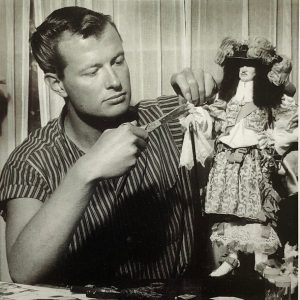
Mr. Stuart, 92, graciously granted an interview for this article. One thing he made clear is that he is a modeller, not a miniaturist. All his figures have been done to ¼ life-size. A favourite subject of his is French royalty: in a photo at left, he is seen working on a figure of King Louis XIV. “I had a very nice communication with Madame Tussaud’s Wax Museum, which had figures of French royalty. They gave me information and photos of the models which I could use.” The palace of Versailles, built by Louis, was an object of particular fascination for him from an early age. “Between the ages of 14 and 18, I built a prodigious white elephant in my backyard: a scale model of Versailles as it appeared in the 1680s. It was three feet high and 8 feet square. I dressed the first floor of it.” Mr. Stuart described Versailles “as the penultimate of anything I’ve seen. Truly glorious architecture.” He said that for him “architecture was the primary art,” and when as a youngster he visited a museum he was more fascinated by the architecture of the building than the treasures it contained.
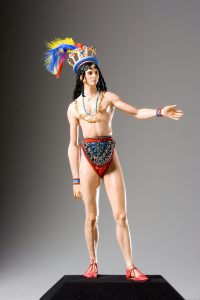
Regarding the figures, the ones on display in Tucson are amongst his earliest, dating from the late 1950s. Thirty-eight of his early figures were sold to the Monsanto Company in 1965, “plus they commissioned half a dozen. That was my first large commission.” For reasons that are unclear, Monsanto sold the figures in the 1970s, but fortunately a canny collector, Eunice Hernandez, began buying them with help from her husband, eventually reuniting 32 of the 38. These were inherited by their daughter, who asked Mr. Stuart to restore them. Upon completion of this task the Mini Time Machine Museum acquired all 32.
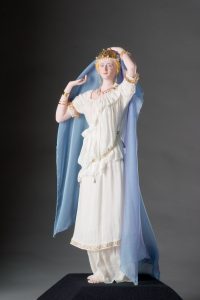
The four on display now are Helen of Troy, Alexander the Great, King Minos of Crete, and Dionysus, the autocratic ruler of Syracuse in Sicily. The viewer is prompted to explore certain topics in relation to each of these. Divine Gifts and Divine Wrath (Minos); Beauty: A Blessing or a Curse (Helen); Blasphemy and Treachery (Dionysus); Man or God (Alexander). I have been to Crete, to see the oldest royal throne in existence, the very one from which Minos ruled. At his death, it is said Zeus appointed him a judge in Hades – thus the divine wrath part of his story. Helen was the nexus of the Trojan War, so her legendary beauty was as much a blessing as a curse. Dionysus has had a bad press: widely regarded as a tyrant, he advanced the technology of military warfare. As for Alexander, I opt for god, just to be on safe side!
Mr. Stuart concentrates on deceased historical figures. “With TV and movies, the visage of living persons are put into our face and one can’t get rid of it. Modellers don’t have much chance of creating a satisfactory replica of somebody’s face anymore.”
Mr. Stuart has perhaps always felt a bit out of synch with the world about him. “America is a forward-looking culture, but I always looked backward. As a child I listened a lot, but I was afflicted with a pretty serious handicap. In my pre-teens I was told I was a nice little boy, but a bit dim. I couldn’t read, and numbers meant nothing but I loved to be read to. Ninety years on I’m still read to today.” Mr. Stuart explained that his parents were always supportive. “They were never critical of me or put me down. It was not until I was 40 that I was diagnosed as having dyslexia.”
He does not advise children these days to become an artist. “Most of the artists I’ve encountered are not capable of pushing themselves forward. Andy Warhol had the antic charisma, but he was an exception. Art for Warhol was all about him. That never occurred to me as a painter, it’s so infantile! None of the figures I have created are anything to do with myself.” On the bright side he noted “there is a little bit of life in restoring liberal arts colleges,” but he noted most major corporations advise young people, especially in tech, not to go to university: ‘we will train you.’
Since he has created more than 400 figures ranging from ancient to modern times, Mr. Stuart has often been asked what time period he would like to live in. “Any one with reliable anesthetic and toilet paper,” he replies!
An extensive gallery of images of figures created by Mr. Stuart is at this link from the Ventura Museum in California, which houses the largest collection of his work:
https://www.galleryhistoricalfigures.com/gallery
The exhibit Favoured by the Gods: Legendary Figures of Ancient Greece is on display in Tucson till Aug 22, 2021. When this is finished, another set of legendary figures from ancient times will be put on display, including King Nebuchadnezzar II of Babylon, the Queen of Sheba, and Assurbanipal, king of Assyria. This continuing exhibit is highly recommended, and the visitor will also have the opportunity of seeing many rooms filled with the most inventive miniature buildings in the permanent collection.
Museum Hours & Location:
Tuesday–Sunday from 9am–4pm
4455 E. Camp Lowell Drive
Tucson, AZ 85712
This article was written by Dr C Cunningham, with a valuable insight (the second paragraph) by Mr C Salgado.
